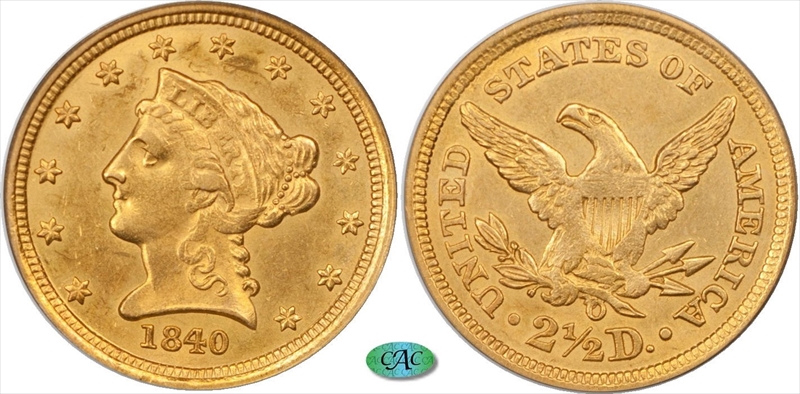1840-O $2.50 AU58 认证号06594378, PCGS号7720
拥有者评论
Winter V-1. The mint mark is large and high compared to the other 2 varieties and diagonal lines are seen above ST in STATES. The strike is notably weak at the center, also a characteristic of this variety. From a mintage of 33,580, about 100-125 remain. This coin is probably a 62-63 technically with no visible wear, but the strike is very soft. CAC
专家评论
Doug Winter
In 1840, the design of the quarter eagle was changed and Christian Gobrecht’s new Coronet or Liberty Head design was introduced. In addition, the mintmark was moved to the reverse. The 1840-O quarter eagle is scarce in all grades and it is a rare issue in About Uncirculated and above. Despite its rarity and historic significance, the issue is still underrated.The 1840-O is popular as the first New Orleans quarter eagle with the Liberty Head design. It is moderately scarce in the lower circulated grades and it becomes very scarce in About Uncirculated. This is a very rare issue in Uncirculated, with most of the known examples grading MS60 to MS62. Well struck pieces with original color are especially hard to locate.
STRIKE: The quality of strike depends on the die variety (see below). All of the Large Mintmark coins that I have seen (Variety 3) are poorly struck with very weak centers. The stars at the left obverse are quite weak, while those at the right have some definition at their centers. The Small Mintmark coins (Variety 1 and Variety 2) have a better strike. They are still not fully defined at the centers but are not nearly as weak as the Large Mintmark coins. The border is much better struck with many of the stars showing full radial lines. It is my opinion that 1840-O quarter eagles that display a good strike should sell for a significant premium over those with a typical weak strike.
SURFACES: The majority of 1840-O quarter eagles are heavily abraded. I have seen a very small number of high grade pieces that were free of significant marks and, surprisingly, some well-worn examples that had clean surfaces but the typical 1840-O shows numerous deep, detracting abrasions.
LUSTER: The luster is usually soft and frosty on the higher grade pieces that are known. There are a small number of semi-prooflike examples but these tend to have numerous abrasions and poor eye appeal. The quality of luster on the average higher grade 1840-O is better than one might generally expect.
COLORATION: This issue has a distinctive medium to deep yellow-gold coloration that can be very attractive. Many have been cleaned or dipped at one time and it is very hard to locate an 1840-O quarter eagle with original color.
EYE APPEAL: The typical 1840-O quarter eagle is poorly struck with washed-out color and above average luster. The lack of detail at the centers on most examples means that the level of eye appeal is far below average. I have seen a few very attractive examples (most notably the Bass II: 331 coin) but these are rare.
DIE CHARACTERISTICS: There are raised die lines to the left of the first two or three stars on the obverse. These appear to fade in later die states and may not be seen on lower grade coins.
MAJOR VARIETIES: There are three major die varieties known:
Variety One: Small Mintmark. The date is placed high in the field. The mintmark touches the arrow feather but it is not penetrated by it. The fraction bar points to the space beyond the right side of the mintmark.
This is the most common variety of the year. It is believed that a total of 10,780 Small Mintmark 1840-O quarter eagles were produced. My estimate it that approximately 75% of these were Variety One.
Variety Two: Small Mintmark. Same obverse as last. The fraction bar points to the lower right side of the mintmark.
A rare variety.
Variety Three: Large Mintmark. Same obverse as the last two. The mintmark, while small, is larger than on Variety 2. There are raised diagonal die lines above the ST in STATES.
A scarce variety, especially in higher grades.
David Akers (1975/88)
Scarce in all grades and extremely difficult to obtain in full mint state. Most known specimens are softly struck, but not as noticeably so as the pieces from the Philadelphia Mint. All the specimens that I have seen have a very tiny mintmark. Very underrated as a date and greatly undervalued, particularly above EF.PCGS #
7720
设计师
Christian Gobrecht
边缘
Reeded
直径
18.00 毫米
重量
4.18 克
铸币数量
33580
金属成分
90% Gold, 10% Copper
更高评级数量
12
评级较低的钱币数量
79
地区
The United States of America
价格指南
PCGS 数量报告
拍卖 - PCGS 评级的
拍卖 - NGC 评级的
稀有性和存量估计 了解更多
| 所有评级 | 125 |
| 60或以上 | 10 |
| 65或以上 | 2 |
| 所有评级 | R-7.7 |
| 60或以上 | R-9.5 |
| 65或以上 | R-9.9 |
| 所有评级 | 48 / 147 TIE |
| 60或以上 | 57 / 147 TIE |
| 65或以上 | 17 / 147 TIE |
| 所有评级 | 48 / 147 TIE |
| 60或以上 | 57 / 147 TIE |
| 65或以上 | 17 / 147 TIE |






















